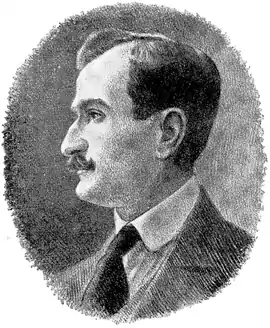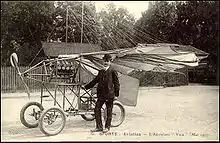Traian Vuia
Traian Vuia or Trajan Vuia (Romanian pronunciation: [traˈjan ˈvuja]; August 17, 1872 – September 3, 1950) was a Romanian inventor and aviation pioneer who designed, built and tested the first tractor monoplane. He was the first to demonstrate that a flying machine could rise into the air by running on wheels on an ordinary road.[2] He is credited with a powered hop of 11 m (36 ft) made on March 18, 1906, and he later claimed a powered hop of 24 m (79 ft).[3][4] Though unsuccessful in sustained flight, Vuia's invention influenced Louis Blériot in designing monoplanes.[5] Later, Vuia also designed helicopters.
Traian Vuia | |
|---|---|
 | |
| Born | August 17, 1872 Surducul-Mic, Austro-Hungarian Empire |
| Died | September 3, 1950 (aged 78) Bucharest, Romania |
| Nationality | Romanian[1] |
| Occupation | Inventor |
| Known for | Early flying machine |
A French citizen from 1918, Vuia led the Romanians (especially Transylvanians) of France in the Resistance during World War II. He returned to Romania just before his death in 1950.[6]
Education and early career
Vuia was born to Romanian parents Simion Popescu and Ana Vuia living in Surducul-Mic, a village in the Banat region, Austro-Hungarian Empire, today in Romania; the place is now called Traian Vuia. After graduating from high school in Lugoj, in 1892, he enrolled in the School of Mechanics at the Polytechnic University of Budapest where he received his engineering diploma. He then joined the Faculty of Law in Budapest, Hungary, where he earned a PhD in law in May 1901 with the thesis "Military and Industry, State and Contract regime".[7]
He returned to Lugoj, where he studied the problem of human flight and designed his first flying machine, which he called the "airplane-car". He attempted to build the machine, but due to financial constraints decided to go to Paris in July 1902, hoping to find someone interested in financing his project, possibly balloon enthusiasts. He met with considerable skepticism from people who believed that a heavier-than-air machine could not fly. He then visited Victor Tatin, the well-known theoretician and experimenter who had built an aircraft model which flew in 1879. Tatin was interested in the project, but doubted that Vuia had a suitable engine or that his aircraft would be stable. Vuia then presented his plan to the Académie des Sciences in Paris on February 16, 1903, but was rejected with the comment, "The problem of flight with a machine which weighs more than air can not be solved and it is only a dream."[8]
Undeterred, Vuia applied for a French patent on May 15, 1903, and obtained patent No. 332106 for his design.[9][10] He began to build his first flying machine in the winter of 1902–03. Overcoming more financial difficulties, he also started construction of an engine of his own design for which he was granted various patents, the first in 1904.[10][11]
Flying experiments

By December 1905 Vuia had finished construction of his first airplane, the "Vuia I". This was a high-wing monoplane constructed entirely of steel tubing. The basic framework consisted of a pair of triangular frames, the lower members forming the sides of the rectangular chassis which bore four pneumatic-tyred wheels, the front pair steerable. The wing was mounted on the apices of these frames and resembled those of Otto Lilienthal's gliders, with a number of curved steel tubes radiating outwards from centres at the apex of each of the side frames, braced by wires attached to a pair of kingposts, and covered in varnished linen. Pitch control was achieved by varying the angle of attack of the wing. A trapezoidal rudder was mounted behind and below the wing.[12] It was powered by a carbonic acid gas engine driving a single tractor propeller. The 25 hp engine had to be adapted by Vuia himself as a suitable engine was not available.[13] Liquid carbon dioxide was vaporized in a Serpollet boiler and fed to a Serpollet engine. The fuel supply was enough for a running time of about five minutes at full power.[14] The aircraft was constructed for Vuia by the Parisian engineering company of Hockenjos and Schmitt.
Vuia chose a site in Montesson, near Paris, for testing. At first he used the machine without the wings mounted so he could gather experience controlling it on the ground. The wings were put on in March and on March 18, 1906, it lifted off briefly. After accelerating for about 50 m (160 ft), the aircraft left the ground and travelled through the air at a height of about 1 m (3 ft 3 in) for a distance of about 12 m (39 ft), but then the engine cut out and it came down. Caught by the wind it was damaged against a tree.[6][15] On August 9 a longer hop of 24 m (79 ft) at a height of about 2.5 m (8 ft) was made, ending in a heavy landing which damaged the propeller.[16]
In August 1906 he modified the aircraft, reducing the camber of the wing and adding an elevator.[17] In this form it is sometimes called the Vuia I-bis. The British aviation historian Charles Harvard Gibbs-Smith described this aircraft as "the first man-carrying monoplane of basically modern configuration", yet "unsuccessful" because it was incapable of sustained flight.[18]
The French journal L'Aérophile emphasized that Vuia's machine had the capability to take off from a flat surface, without assistance such as an incline, rails, or catapult.[19] At the time Europe was aware of the efforts of the Wright brothers who on December 17, 1903, had flown their Wright Flyer from level ground using a dolly undercarriage running on a guide rail into a 20 mph headwind, though few yet recognised the achievement. The Wrights had made sustained and controlled flights in a complete circuit by September 1904.[20]
The main characteristics of the Vuia I:[21]
- Span : 8.70 m (28.7 ft)
- Length : 5.65 m (18.6 ft)
- Height : 2.90 m (9.5 ft)
- Lifting surface : 20 sq.m (217 sq.ft)
- Engine (using carbonic acid as fuel): 25 hp
- Propeller: 2-bladed, 2.2 m (7 ft 2 in) diameter, designed by Victor Tatin.
- Weight: 241 kg (531 lb) including fuel and pilot

In 1907 Vuia built the Vuia II, using an Antoinette 25 horsepower (19 kilowatts) internal combustion engine. This aircraft had the same basic configuration as the Vuia I-bis, but was both smaller and lighter, with a total weight (including pilot) of 210 kg (460 lb) and a wingspan of 7.9 metres (26 ft).[22] Vuia succeeded in making a brief powered hop on July 5, travelling 20 m (66 ft), but damaging the aircraft and suffering slight injuries on landing.[23] No further attempts were made to fly the aircraft.[24]
Charles Dollfus, former curator of the Air Museum in Paris, wrote that aviation pioneer Alberto Santos Dumont's use of wheels on his aircraft was influenced by Dumont's having seen Vuia's flight attempts.[15]
Documentation
Vuia reportedly made his first powered hop on March 18, 1906, in the presence of his mechanic and two close friends. Accounts of this test, published at the time, and of his later airborne tests, till August 19, 1906, are based on letters he wrote to L'Aérophile, the official journal of the Aéro Club of France.[25] Vuia made the first known public demonstration of his airplane on October 8, 1906, when he became airborne for four meters, witnessed by Ernest Archdeacon and Édouard Surcouf.[17] Another journal of the period, Flight, credited him with a five-meter hop on October 8, 1906, as the earliest entry in a list of his tests shown in a table of "the performances which have been made by the most prominent aviators of the last few years".[26]
Later career

Between 1918 and 1921 Vuia built two experimental helicopters on the Juvisy and Issy-les-Moulineaux aerodromes.[15][27]
He is buried at the Bellu cemetery in Bucharest, Romania.[28]
Legacy
Another invention by Vuia was a steam generator with internal combustion that generates very high pressure – more than 100 atm (10 MPa) – that is still used today in thermal power stations. Traian Vuia and one of his partners, Emmanuel Yvonneau, patented several types of gas generators.[7][29]
On May 27, 1946, Vuia was named an Honorary Member of the Romanian Academy.[30]
His birthplace, Bujoru, in Timiș was renamed Traian Vuia after his death.
Timişoara International Airport Traian Vuia (TSR), Romania's third largest airport, carries his name.
Gallery
.png.webp)
Vuia I .png.webp)
Vuia I 
Vuia II .png.webp)
Vuia II 
Vuia helicopter
See also
References
- Vuia was born to ethnically Romanian parents in the Kingdom of Hungary in territory that became part of Romania.
- Chanute, Octave (October 1907). "Pending European Experiments in Flying". The American Aeronaut and Aerostatist. 1 (1): 13.
- Mola, Roger A (August 2009), "The Birthplaces of Aviation. It didn't all happen at Kitty Hawk", Air & Space Magazine
- Angelucci,E. and Matricardi, P.; "World Aircraft: Origins–World War 1", Sampson Low (1977).
- Gibbs-Smith, Charles Harvard (1965). The world's first aeroplane flights (1903–1908) and earlier attempts to fly. Her Majesty's Stationery Office. p. 31.
- Orna 1956, p. 366.
- "Traia Vuia History", Early Aviators, retrieved October 14, 2010.
- "Traian Vuia". Hargrave: The Pioneers. Centre for Telecommunications and Information Engineering, Monash University. Retrieved June 29, 2010.
- Aéroplane automobile (French Patent), Espace net, FR332106.
- Traian Vuia – a Century of Aviation
- Romanian Aviation Pioneers Romainian Coins
- "L'Aéroplane sur Roues de M, Vuia". l'Aérophile (in French): 54–5. February 1906..
- Orna 1956, p. 365.
- "Ten Years Ago", Flight, vol. VIII no. 43, p. 908, 19 October 1916 – via Flightglobal,
excerpts from the Auto, Flight’s precursor and sister journal
. - Hadirca, Dan. "Traian Vuia". Century of Aviation. Romanian Academy Library. Retrieved March 18, 2012.
- "L'Aéroplane à Moteur de M. Vuia". L'Aérophile (in French). September 1906. pp. 195–6.
- "L'Aéroplane Vuia" [The Vuia aircraft], L'Aérophile (in French), 14, pp. 242–43, October 1906
- Gibbs-Smith, Charles Harvard (3 April 1959), "Hops and Flights", Flight, Iliffe & Sons, vol. 75 no. 2619, p. 469 – via flightglobal.com
- "L'Aéroplane sur Roues de M. Vuia" [Mr Vuia's aircraft on wheels], L'Aérophile (in French), vol. 14, p. 53, February 1906.
- Gibbs-Smith 1970, pp. 100–2.
- "L'Aéroplane sur Roues de M. Vuia". L'Aérophile (in French). February 1906. p. 54.
- "L'Aéroplane Vuia No.2". l'Aérophile (in French): 194. June 1907.
- "Essais de L'Aéroplane Vuia No.2" [Trials of the Vuia No.2 aeroplane]. l'Aérophile (in French): 196. July 1907.
- Gibbs-Smith 1970, p. 144.
- Orna 1956, p.365
- "Progress of Mechanical Flight", Flight, p. 12, 2 January 1909
- Patent (PDF), US, 1423636.
- Catillon, Marcel (1997). Mémorial aéronautique: qui était qui? [Aeronautical memorial: who was who?] (in French). Nouvelles Editions Latines. p. 160. ISBN 978-2-7233-0529-7.
- Steam generator patent
- Member list, Romanian Academy.
Bibliography
- Gibbs-Smith, Charles Harvard (1970). Aviation: an historical survey from its origins to the end of World War II. London: Her Majesty's Stationery Office. ISBN 9780112900139.
- Orna, Bernard (30 March 1956). "Modest Experimenter – Vuias Powered Flights: the Successes of a Little-known Pioneer". Flight. pp. 365–66.
External links
| Wikimedia Commons has media related to Traian Vuia (aviation pioneer). |
- Patents of Trajan Vuia on Espace net.
- Trajan Vuia on Early aviators.
- Aviation Timeline 1906, Century of flight.
- The Traian Vuia 1 on historicwings.com.